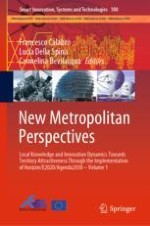This book explores the role of cities and the urban–rural linkages in spurring innovation embedded in spatial planning, strategic and economic planning, and decision support systems. In particular, the contributions examine the complexity of the current transitional phase towards achieving smart, inclusive and sustainable growth, and investigate the post-2020 UE cohesion policy.The main topics include: Innovation dynamics and smart cities; Urban regeneration – community-led and PPP; Inland and urban area development; Mobility, accessibility, infrastructures; Heritage, landscape and Identity; and Risk management, Environment and Energy.The book includes a selection of articles accepted for presentation and discussion at the 3rd International Symposium New Metropolitan Perspectives (ISTH2020), held at the University of Reggio Calabria, Italy on 22–25 May 2018. The symposium, which addressed the challenge of local knowledge and innovation dynamics towards territory attractiveness, hosted the final event of the MAPS-LED project under Horizon2020 – MSCA RISE.
